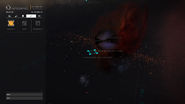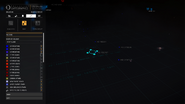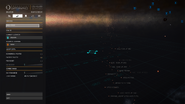A Star Cluster or star cloud is a group of stars. There are two types of star clusters: Globular Clusters and Open Clusters. Globular Clusters are a tight group of hundreds or thousands of stars, which are gravitationally bound.
There are a variety of star clusters in Elite Dangerous that contain rich survey data opportunities.
Trumpler 16

Trumpler 16
Trumpler 16 is the home of WR 25 (not the actual in-game designation), currently the most luminous star known in our Milky Way galaxy, together with the less luminous but more massive and famous Eta Carinae star system and the O2 supergiant HD 93129A (not the actual in-game designation).
Trumpler 16 can be reached by navigating to CPD-59 2574.
Eta Carinae can be located by name, using the search tool.
Trumpler 14

Trumpler 14
Trumpler 14 is about half a million years old and one of the youngest known star clusters in the galaxy. Due to its location within the inner parts of the Carina Nebula, Trumpler 14 is currently undergoing massive star formation. As a result, the star cluster exhibits many stars of late O to early A spectral type, which are very massive (at least 10 solar masses), short-lived and hot (20000 K).
Trumpler 14 can be reached by navigating to CPD-57 3518.
A class A blue supergiant can be located near the cluster by navigating to HD 91969.
Messier 67
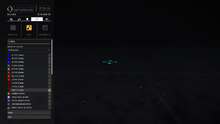
Messier 67
Messier 67 (also known as M67, NGC 2682, or the Cancri Cluster) is an open cluster in the constellation of Cancer.
The cluster had previously been out of reach, due to the 219 light-year gap between OUTOTCH SA-U D4-O and AH CANCRI. However, due to a recent discovery of a massive FSD boost via neutron star, what is known as the "Cancri Climb" became possible. M67 does not contain any neutron stars and thus the trip home is currently impossible.
Messier 67 can be found by searching for NGC 2682 FBC 4778.
NGC 3590
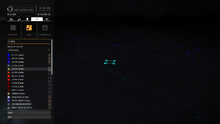
NGC 3590
NGC 3590 is a small open cluster of stars located in the constellation of Carina (the Keel) and is roughly 35 million years old.
NGC 3590 can be reached by navigating to 2MASS J11130656-6047542.
Pleiades Nebula

Pleiades Nebula
The Pleiades (also known as the Seven Sisters, Messier 45, or M45), is an open star cluster containing middle-aged, hot B-type stars that have formed within the last 100 million years. It is located in the constellation of Taurus.
The cluster is at the center of excitement due to the discovery of intelligent alien life.
- Alien Structure
- Alien Crash Site
- Thargoid Interceptor
- Thargoid Surface Site
- Unknown Probe
- Unknown Artefact
The Pleiades can be reached by navigating to Pleiades, which will bring you to Maia. There, you can find the only space station available in the area.
Objects near the nebula
- Iota Andromedae is a star in the constellation Andromeda. It is approximately 500 LYs from Earth.
- Taurus Dark Region.
- 39 Delta Persei black hole.
Orion Nebula
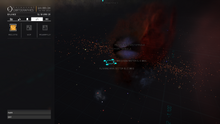
Orion Nebula
The Orion Nebula (also known as Messier 42, M42, or NGC 1976) is a diffuse nebula situated in the Milky Way. It is one of the brightest nebulae and is visible to the naked eye in the night sky. The M42 nebula is estimated to be 24 LYs across. It is one of the most scrutinized and photographed objects in the night sky and is among the most intensely studied celestial features. The Orion Nebula contains a very young open cluster, known as the Trapezium due to the asterism (any pattern of stars recognized in the Earth's night sky) of its primary four stars.
There are seven star clusters associated with the nebulae in the Orion region:
- Trapezium
- NGC 1981
- Collinder 70
- Collinder 69
- NGC 1976
- NGC 1977
- NGC 2232
Trapezium
The Trapezium or Orion Trapezium Cluster, also known by its Bayer designation of Theta Orionis, is a tight open cluster of stars in the heart of the Orion Nebula, in the constellation of Orion. It is a relatively young cluster that has formed directly out of the parent nebula and may be a sub-component of the larger Orion Nebula Cluster.
This star cluster is most readily identifiable by the asterism of four relatively bright stars for which it is named. The four are often identified as A, B, C, and D in order of increasing right ascension. The brightest of the four stars is C, or Theta Orionis C.
NGC 1981

NGC 1981
NGC 1981 is a young, bright open cluster visible in the constellation of Orion. It is a collection of about 20 or so stars (largely magnitudes 7 through 10) and is about 40 LYs closer to Earth than the Orion Nebula.
Collinder 70
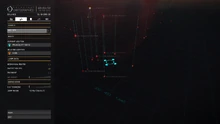
Collinder 70
Collinder 70 is a large open cluster, located around the belt of Orion. It includes all three belt stars: Mintaka (the Girdle), Alnilam (The string of Pearls) and Alnitak (the Belt). The cluster has a diameter of almost 3 degrees and consists of 100 stars or more.
Collinder 69

Collinder 69
Collinder 69 is an open star cluster located north-west of the star Betelgeuse in the constellation of Orion. It is about five million years old and roughly 1,300 ly (400 pc) away from the Sun. Included within the cluster is a double star named Meissa (Lambda Orionis).
NGC 1976

NGC 1976
The Orion Nebula.
NGC 1977

Running Man Nebula
This reflection nebula, also known as the Running Man Nebula, is located in the constellation of Orion about 1,500 light years from Earth.
NGC 2232

NGC 2232
NGC 2232 is a bright open star cluster in the constellation Monoceros centered on the star 10 Monocerotis. It consists of about 20 stars.
- These group of clusters can be found by navigating to HD 36560.
- Theta Orionis C can be found using the search feature on the galaxy map.
- NGC 1981 can be found by navigating to NGC 1981 Sector YZ-Y C11. A class A Blue Supergiant can be found near this cluster by navigating to HD 37660.
Both Collinder 70 and 69 are particularly difficult to make out in the rich star-field found in the Orion Nebula. The most noticeable clustering of these stars are possible to find through the following:
- Collider 70 can be reached by navigating to COL 70 SECTOR MR-U C3-8.
- Collinder 69 can be reached by navigating to DM99 8.
- Mintaka and Alnitak can be found by searching for them via the galaxy map.
- NGC 2232 can be found by navigating to 10 Monocerotis.
Objects near the nebula
- IC 418 (also known as the Spirograph Nebula), is a planetary nebula in the Milky Way Galaxy. It can be reached by navigating to BD-12 1172.
- The carbon star R Leporis, sometimes called Hind's Crimson Star, is a well-known variable star in the constellation Lepus, near its border with Eridanus. R Leporis can be found by navigating to R Leporis.
- IC 2118 (also known as the Witch Head Nebula due to its shape) is an extremely faint reflection nebula believed to be an ancient supernova remnant or gas cloud illuminated by nearby supergiant star Rigel in Orion. The Witch Head Nebula can be reached by navigating to the Witch Head Nebula.
- The nebula Messier 78 (also known as M 78 or NGC 2068) is a reflection nebula in the constellation Orion. It can be found by navigating to Messier 78.
- NGC 1999 is a dust-filled bright nebula with a vast hole of empty space represented by a black patch of sky, as can be seen in the photograph. It is a reflection nebula, and shines from the light of the variable star V380 Orionis.
- v615 Orionis.
- The Running Man Nebula, Barnard's Loop, The Horsehead Nebula, the Flame Nebula, the Horsehead Dark Region, and the Orion Dark Region are all clearly visible within this region.
NGC 7822 Nebula
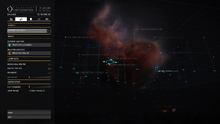
NGC 7822 Nebula
NGC 7822 is a young star-forming complex in the constellation of Cepheus. The complex also includes one of the hottest stars discovered within 1 kpc of the Sun, within an eclipsing binary system. The star is one of the primary sources illuminating the nebula and shaping the complex famed pillars of creation-type formations, the elephant trunks.
This is a very lucrative destination, as it features scores of O-Type stars and black holes.
NGC 7822 can be found by navigating to S171 33.
NGC 1893
NGC 1893 is an open cluster in the constellation Auriga.

NGC 1893
This is an open cluster of class B stars. As such it is nothing especially remarkable except that it sits within the sparsely populated rift within the Outer Arm Vacuus, thus making them really stand out against the sparsely populated backdrop. The cluster requires an engineered frameshift drive or the use of FSD boosts to reach."
NGC 1893 can be found by navigating to NGC 1893 CF 43.
NGC 2099

NGC 2099
NGC 2099 (also known as M37 or Messier 37) is the richest open cluster in the constellation Auriga. It is a widely dispersed open cluster situated on the far side of the Orio-Persean Gap, approx. 4,200 LYs from Sol.
NGC 2099 can be found by navigating to NGC 2099 PPM 27.
IC 1590

IC 1590
IC 1590 is an open cluster in Cassiopeia. It is a part of emission nebula NGC 281 ("PacMan Nebula") and includes the multiple star HD 5005, and several Bok globules (dark nebulae).
IC 1590 is nestled within NGC 281. Within the heart of the nebula is the likely candidate for the multiple star HD 5005, which has 4 O-Type stars.
These objects can be reached by navigating to BD+55 191.
The Jewel Box

The Jewel Box
The Jewel Box (Kappa Crucis Cluster or NGC 4755) is an open cluster in the constellation Crux. This cluster is one of the youngest known, with an estimated age of 14 million years, and is considered one of the finest objects in the southern sky.
The Jewel Box can be found by navigating to NGC 4755 MG 215.
Double Cluster
The Double Cluster (also known as Caldwell 14) is the common name for the open clusters NGC 869 and NGC 884 (often designated h Persei and χ Persei, respectively), which are close together in the constellation Perseus.
NGC 869

NGC 869
Sometimes called the h Persei Cluster, this is an open cluster in the constellation of Perseus and is a member of the Perseus OB1 association. It is thought to be some 13 million years old and is the easternmost of the Double Cluster with NGC 869. Both clusters are located only a few hundred light years apart.
NGC 884

NGC 884
Also known as the Chi Persei Cluster, this is an open cluster of bright O-type and B-type stars and a part of the Perseus OB1 association. Several neutron stars and black holes can also be found as companions. The cluster is also notable for having several supergiants within it (FZ Persei, RS Persei, V439 Persei, V403 Persei and HD 14143).
NGC 869 can be found by navigating to NGC 869 LAV 1101.
NGC 884 can be found by navigating to NGC 884 HG 1772.
The Hyades

Hyades
The Hyades (also known as Melotte 25 or Collinder 50) is the nearest open cluster to the Solar System and one of the best-studied star clusters. The age of the cluster is estimated to be about 625 million years old. From the perspective of observers on Earth, the Hyades Cluster appears in the constellation Taurus, where its brightest stars form a "V" shape along with the still brighter red giant Aldebaran. However, Aldebaran is unrelated to the Hyades, as it is located much closer to Earth (hence its apparent brightness) and merely happens to lie along the same line of sight.
The Hyades can be found by navigating to Hyadum I.
Collinder 121
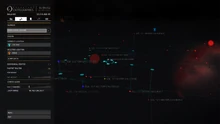
Collinder 121
This is an extensive stellar association visible in the constellation of Canis Major. The concentration of stars here are scattered over a wide area, and thus difficult to pinpoint on the map.
Collinder 121 can be found by navigating to Sigma Canis Majoris.
Collinder 470 Supercluster

Collinder 470
Also known as IC 5146, Caldwell 19, Sh 2-125, and the Cocoon Nebula, Collinder 470 is 750 light years long, but averaging only 20 light years wide. It is located in the constellation Cygnus and is surrounded by the dark nebula, Barnard 168.
Collinder 470 can be found by navigating to V1578 Cygni.
The Christmas Tree Cluster

The Christmas Tree Cluster
The Christmas Tree Cluster is a young open cluster located in the constellation Monoceros. It is part of the NGC 2264 region, along with the Cone Nebula. Two other objects are within this designation but not officially included:
- Snowflake Cluster
- Fox Fur Nebula
All of the objects are located in the Monoceros constellation and are located about 800 parsecs or 2600 light years from Earth.
Christmas Tree Cluster can be found by navigating to PQ Monocerotis.
Collinder 140

Collinder 140
Collinder 140 is an open cluster that contains approximately 40 stars and is estimated to be some 20 million years old. Its central star, HIP 38064, features unusually large stellar objects with rings, including an M-class star, a class L-dwarf and two Y-class dwarfs. The O-class primary star lights up the rings with vivid blue and purple colors.
The nearest two planets are in inside the star's corona, and in close proximity to each other, causing spectacular views. Planet 2 contains a tourist beacon with information on the original discovery of this area. Commanders should take great care when landing on planet 2; high gravity is present, and proximity to the star may cause overheating.
Collinder 140 can be found by navigating to HIP 38064.
The Running Chicken Cluster

The Running Chicken Cluster
Also known as IC 2944, or the λ Centauri Nebula, is an open cluster with an associated emission nebula found in the constellation Centaurus, near the star λ Centauri. It features Bok globules, which are frequently a site of active star formation. Neither the globules nor the Nebula are officially included in the game.
The Running Chicken Cluster can be found by navigating to IC 2944 HG 10004.
Messier 6 (NGC 6405)

Messier 6
Also known as the Butterfly Cluster, or NGC 6405, is an open cluster of some 80 stars in the constellation of Scorpius. Its name derives from the vague resemblance of its shape to a butterfly. Most of the bright stars in this cluster are hot, blue B-type stars but the brightest member is a K-type orange giant star, the B-type binary V970 Scorpii.
Messier 6 can be found by navigating to HD 160167.
NGC 6530

NGC 6530
NGC 6530 is an extremely young open cluster in the constellation Sagittarius. It has a diameter of 10 arc minutes, and class G with stars as bright as 7th magnitude. It exists within Nebula Messier 8, the Lagoon Nebula.
NGC 6530 can be found by navigating to NGC 6530 CDZ 99.
Messier 34 (NGC 1039)

Messier 34
Also known as M 34, or NGC 1039, is an open cluster in the constellation Perseus. The age of this cluster lies between the respective ages of the Pleiades open cluster at 100 million years and the Hyades open cluster at 800 million years. It is approximately 1,800 light years from Sol.
Messier 34 can be found by navigating to V823 Persei.
NGC 1333 Reflection Nebula & Supercluster

NGC 1333 Reflection Nebula & Supercluster
NGC 1333 is a reflection nebula located in the constellation Perseus. It belongs to the Perseus molecular cloud. It is approximately 1,200 light years from Sol.
NGC 1333 can be found by navigating to GMM2008 22.
NGC 1647

NGC 1647
NGC 1647 is an open cluster in the constellation Taurus. It contains nearly 90 stars and it lies at a distance of 550 parsec. This small cluster, consisting mainly of young blue and white stars, is approx. 1,800 LYs from Sol, on the edge of the Orion arm.
NGC 1647 can be found by navigating to BD+18 718.
Eorgh Stellar Forge

Eorgh Stellar Forge (1)
This appears to be star cluster located about a thousand light years from Colonia. Official cluster name is unknown.
It is clearly visible upon approach and is illuminated with numerous A and B-type stars.

Eorgh Stellar Forge (2)
The Eorgh Stellar Forge can be found by navigating to EORGH PROU WE-H AB-2.
NGC 6231

NGC 6231
NGC 6231 is an open cluster located near Zeta Scorpii. This cluster is estimated to be about 3.2 million years old, and is approaching the Solar System at 22 km/s.
NGC 6231 can be found by navigating to NGC 6231 BVF 50.






